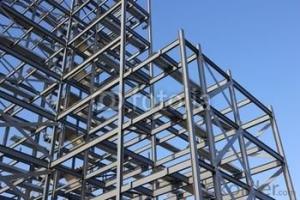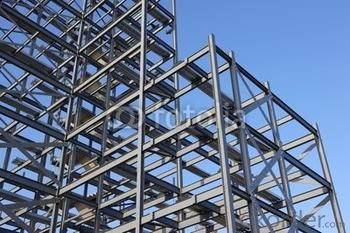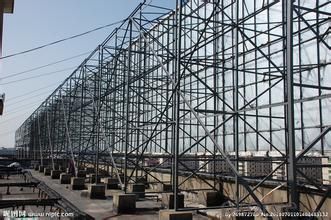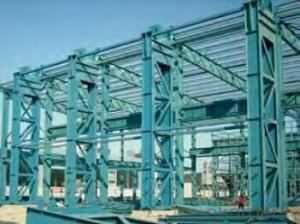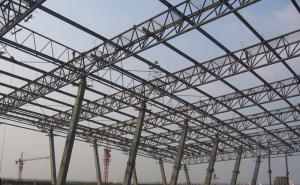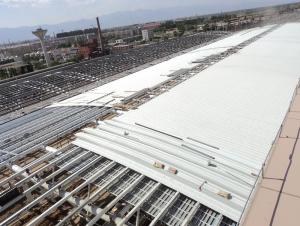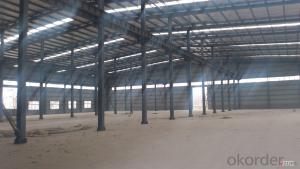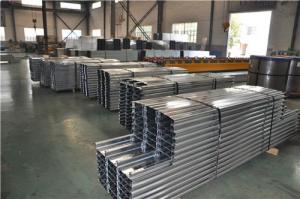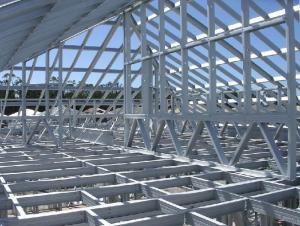Light Steel Structure Workshop With High Quality
- Loading Port:
- China Main Port
- Payment Terms:
- TT or LC
- Min Order Qty:
- -
- Supply Capability:
- -
OKorder Service Pledge
OKorder Financial Service
You Might Also Like
Product Description:
OKorder is offering Light Steel Structure Workshop with high quality at great prices with worldwide shipping. Our supplier is a world-class manufacturer of steel, with our products utilized the world over. OKorder annually supplies products to European, North American and Asian markets. We provide quotations within 24 hours of receiving an inquiry and guarantee competitive prices.
Product Applications:
Light Steel Structure Workshop with high quality are ideal for structural applications and are widely used in the construction of buildings and bridges, and the manufacturing, petrochemical, and transportation industries.
Product Advantages:
Light Steel Structure Workshop with high quality are durable, strong, and resist corrosion.
Main Product Features:
· Premium quality
· Prompt delivery & seaworthy packing (30 days after receiving deposit)
· Corrosion resistance
· Professional Service
· Competitive pricing
Product Specifications:
Project type: UHV alternating-current transformer and electric reactor workshop and equipment steel structure
The steel dosage: 1275MTs
Building area: 12500M2
The unit component weight: 11.4MTs
The span: 24m
1. GB standard material
2. High Structural safety and reliability
3. The production can reach GB/JIS/ISO/ASME standard
1. According to the project design and the component size, usually the main component parts are nude packing and shipped by bulk vessel. And the small parts are packed in box or suitable packages and shipped by containers.
2. This will be communicated and negotiated with buyer according to the design.
Tekla Structure \ AUTO CAD \ PKPM software etc
⊙Complex spatial structure project detailed design
⊙Construct 3D-model and structure analysis. ensure the accuracy of the workshop drawings
⊙Steel structure detail ,project management, automatic Shop Drawing, BOM table automatic generation system.
⊙Control the whole structure design process, we can obtain higher efficiency and better results
FAQ:
Q1: Why buy Materials & Equipment from OKorder.com?
A1: All products offered byOKorder.com are carefully selected from China's most reliable manufacturing enterprises. Through its ISO certifications, OKorder.com adheres to the highest standards and a commitment to supply chain safety and customer satisfaction.
Q2: How do we guarantee the quality of our products?
A2: We have established an advanced quality management system which conducts strict quality tests at every step, from raw materials to the final product. At the same time, we provide extensive follow-up service assurances as required.
Q3: How soon can we receive the product after purchase?
A3: Within three days of placing an order, we will begin production. The specific shipping date is dependent upon international and government factors, but is typically 7 to 10 workdays.
Images:
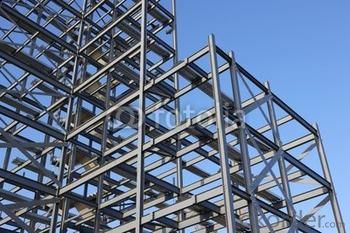
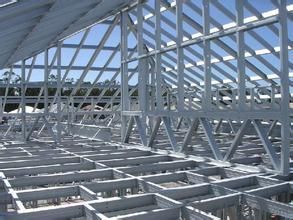
- Q: How are steel structures used in the construction of bars and pubs?
- Bars and pubs commonly utilize steel structures due to the numerous advantages they offer. The strength and durability of steel make it an ideal material for supporting heavy loads and creating large open spaces with various design features. For the framing and support systems in bars and pubs, steel structures are frequently employed. Steel beams and columns ensure the necessary structural integrity to withstand the weight of the roof, floors, and walls. Furthermore, steel's fire resistance is crucial in establishments serving alcohol with a higher risk of accidents. The use of steel structures allows for greater design flexibility. Steel can be molded and shaped into different forms, enabling architects and designers to create unique and visually appealing layouts. This versatility is particularly advantageous in bars and pubs where creating an inviting atmosphere is important. Another significant benefit of steel structures is their ability to span large distances without the need for intermediate support columns. This allows for open floor plans, optimizing space usage and providing better sightlines for patrons. Moreover, steel structures are often pre-fabricated off-site, reducing construction time and costs. This is particularly beneficial in the hospitality industry, where time is crucial, and delays can impact revenue generation. Pre-fabricated steel components speed up the construction process and minimize disruption to the surrounding area. Steel structures also offer long-term cost savings. Due to its low-maintenance nature and resistance to pests, rot, and decay, steel does not require frequent repairs or replacements. This makes it an excellent choice for durable and long-lasting construction. In conclusion, steel structures are essential in the construction of bars and pubs. Their strength, durability, fire resistance, versatility, and cost-effectiveness make them the practical choice for creating inviting and visually appealing spaces in the hospitality industry.
- Q: What are the considerations for designing steel high-rise buildings?
- Some considerations for designing steel high-rise buildings include structural stability, wind and seismic resistance, fire protection, thermal performance, and construction efficiency.
- Q: What is the difference between a steel structure and a steel silo?
- A steel structure refers to a building or framework made entirely or predominantly of steel, typically used for construction purposes. On the other hand, a steel silo is a specific type of steel structure designed specifically for storing bulk materials, such as grain, cement, or chemicals. The primary difference lies in their purpose and design, with steel structures being versatile for various construction applications, while steel silos are specialized for storage purposes.
- Q: The position of the steel structure requires a spring cushion for mounting the bolt
- Ordinary bolts: the bolts must be tightened so as to prevent the bolts from loosening. A spring washer prevents looseness between the connecting plate and the nut. When the nut is preloaded, the gasket is flattened to produce an elastic reaction force that forces the screw between the threads to increase friction and prevent looseness. However, due to uneven elasticity, the shock loading during operation results in poor looseness of the gasket. Generally used in less important connections.
- Q: How does steel contribute to sustainable construction?
- There are several ways in which steel contributes to sustainable construction. Firstly, steel is a material with high durability, meaning that structures made with steel have a longer lifespan compared to other construction materials. This reduces the need for frequent repairs and replacements, resulting in less waste and resource consumption over time. Secondly, steel is a recyclable material, which means it can be reused multiple times without losing its properties. This significantly reduces the demand for new steel production and helps conserve natural resources. In fact, steel is one of the most recycled materials globally, with a high recycling rate that minimizes the environmental impact of construction projects. Additionally, steel is known for its strength and load-bearing capabilities, allowing for the construction of lighter and more efficient structures. This leads to reduced energy consumption during the construction process and throughout the lifespan of the building. Moreover, steel structures can be designed to be more flexible and adaptable, enabling future modifications and reducing the need for complete demolition and reconstruction. Furthermore, steel is resistant to fire, pests, and natural disasters, making it a safer choice for construction. This enhances the longevity and resilience of buildings, reducing the need for frequent repairs or rebuilding in the face of unforeseen events. Lastly, steel is manufactured with high precision and quality control, resulting in a reliable and consistent material that can be easily integrated into modern construction techniques. This ensures that steel structures meet the required safety and performance standards, offering peace of mind to builders, occupants, and regulators. In conclusion, steel contributes to sustainable construction by providing durability, recyclability, energy efficiency, safety, and adaptability. Its longevity, recyclability, and strength make it an environmentally friendly choice, while its resistance to various threats and precision manufacturing make it a reliable and safe option. By incorporating steel into construction projects, we can create buildings that are not only aesthetically pleasing but also environmentally responsible and long-lasting.
- Q: What are the advantages of using steel structures in bridge construction?
- There are several advantages of using steel structures in bridge construction. Firstly, steel is a very strong and durable material, allowing bridges to withstand heavy loads and harsh weather conditions. Secondly, steel structures are lightweight compared to other materials like concrete, which makes them easier and faster to construct. Thirdly, steel is highly flexible and can be shaped into various designs, allowing for creative and aesthetically pleasing bridge structures. Additionally, steel is a recyclable material, making it an environmentally friendly choice. Lastly, steel structures require minimal maintenance and have a long lifespan, resulting in cost savings in the long run.
- Q: Measures to prevent rust in welded seam of steel structure
- 95% pure zinc protective film can effectively resist rust and corrosion, providing years of rust protectionBecause of the strong permeability, after the protective film has been scraped, the zinc can protect the metal from corrosionRepairing damaged metal surface is effective, used for welding seam repair.
- Q: What is an assembled steel structure?
- What we are doing now is assembly type, also called prefabricated type. What our company has been doing. Nothing new. The Eiffel Tower in France is an assembly, although it was a tower built in 1889, but it was fully assembled, the tallest tower in the world at that time.
- Q: What are the design considerations for steel structures in extreme weather conditions?
- Design considerations for steel structures in extreme weather conditions include: 1. Structural stability: The design must ensure that the steel structure can withstand high winds, heavy snow loads, and seismic activity. This involves proper sizing of members, connections, and bracing systems to prevent excessive deformation or failure. 2. Corrosion protection: Steel structures in extreme weather conditions are often exposed to moisture, salt, and other corrosive elements. Adequate measures such as galvanization, painting, or applying protective coatings should be taken to prevent rust and ensure the longevity of the structure. 3. Thermal expansion and contraction: Extreme temperature variations can cause steel to expand or contract significantly. Proper detailing and provision for thermal movement must be incorporated into the design to avoid structural damage or failure. 4. Wind resistance: In areas prone to hurricanes or high wind speeds, steel structures need to be designed to resist uplift forces, lateral loads, and vortex shedding. This may involve using aerodynamic shapes, bracing systems, or wind-resistant connections. 5. Snow load considerations: Steel structures in regions with heavy snowfall need to account for the weight of accumulated snow. The design should ensure adequate strength and stiffness to support the loads and prevent excessive deflection or collapse. 6. Foundation design: Extreme weather conditions can affect the soil stability and load-bearing capacity of the foundation. The design must consider factors such as frost heave, soil erosion, or liquefaction to ensure a stable foundation for the steel structure. 7. Fire resistance: Extreme heat or wildfires can pose a significant risk to steel structures. Fire-resistant coatings, fireproofing materials, or incorporating fire-resistant design features are essential to protect the structure and ensure occupant safety. Overall, the design of steel structures in extreme weather conditions requires a comprehensive understanding of the local climate, environmental factors, and the behavior of steel under different loads and conditions.
- Q: How are steel structures used in the construction of observatories?
- Steel structures are commonly used in the construction of observatories due to their strength, durability, and versatility. They provide the necessary support and stability for telescopes and other equipment, allowing for precise calibration and accurate observations. Steel also allows for the construction of large, open spaces, such as domes or towers, which are essential for housing telescopes and providing unobstructed views of the night sky. Additionally, steel structures can withstand harsh weather conditions and seismic activity, ensuring the long-term integrity and safety of observatories.
Send your message to us
Light Steel Structure Workshop With High Quality
- Loading Port:
- China Main Port
- Payment Terms:
- TT or LC
- Min Order Qty:
- -
- Supply Capability:
- -
OKorder Service Pledge
OKorder Financial Service
Similar products
Hot products
Hot Searches
